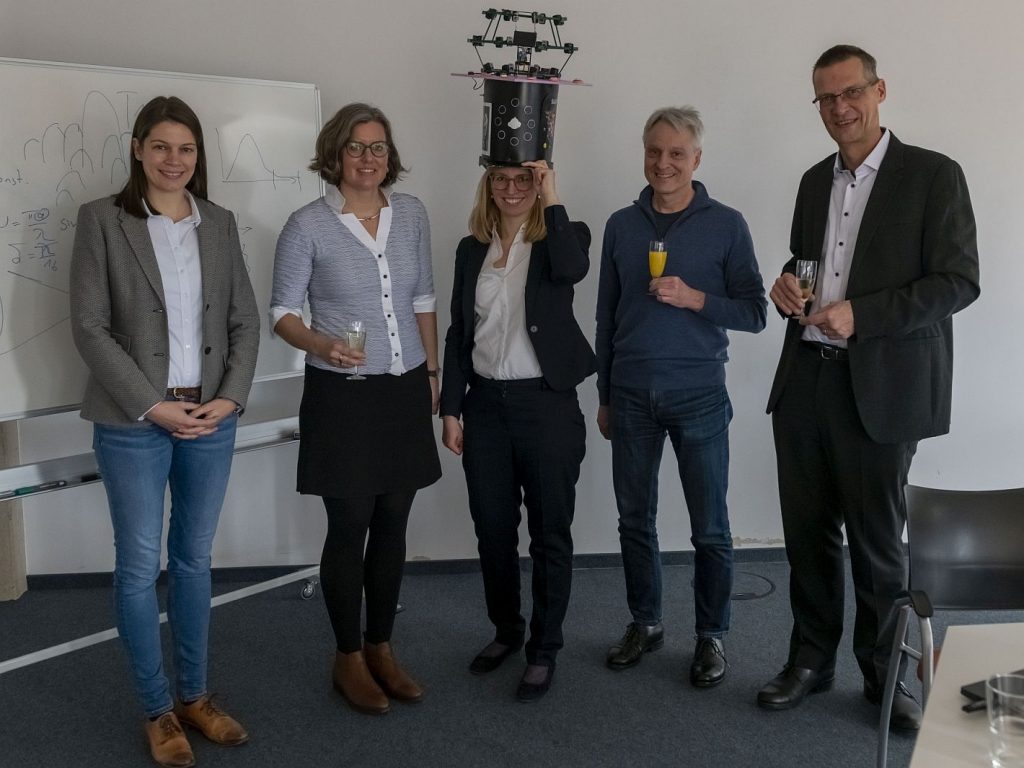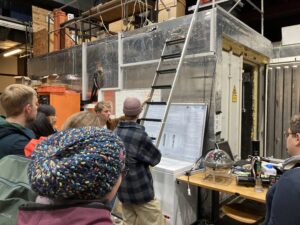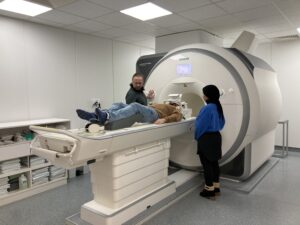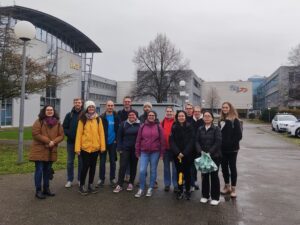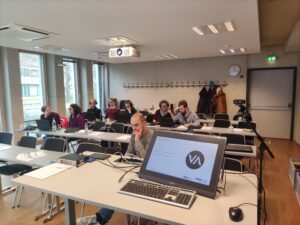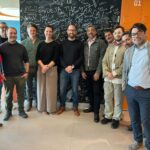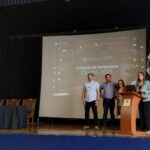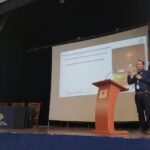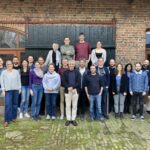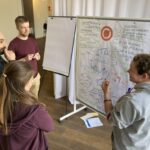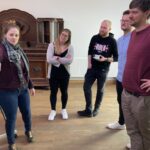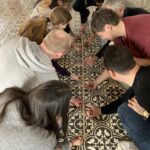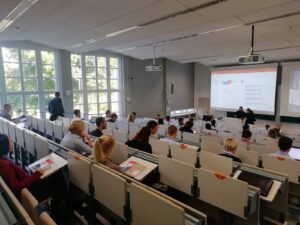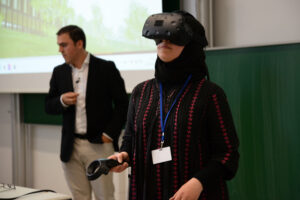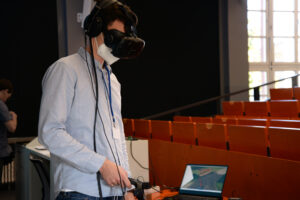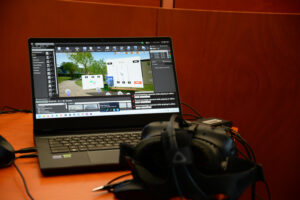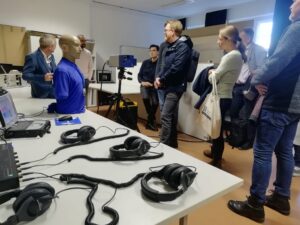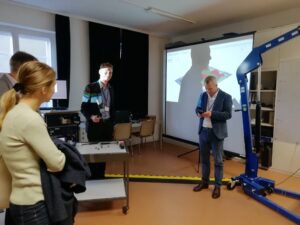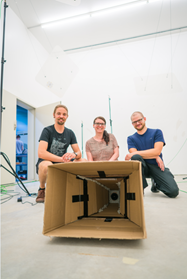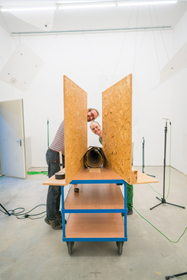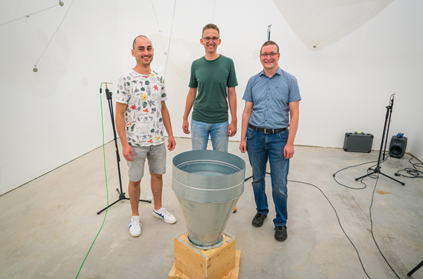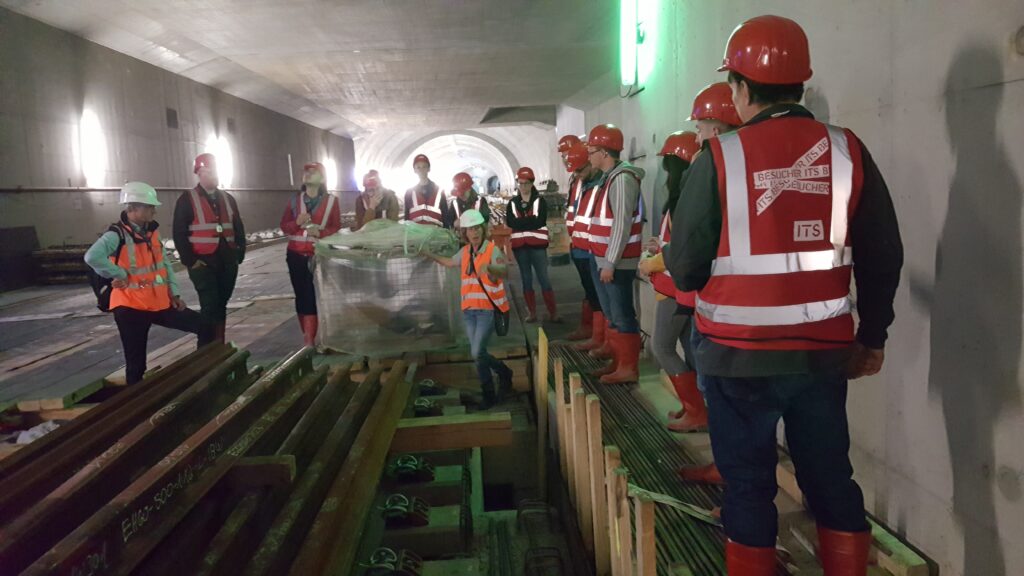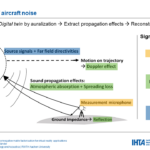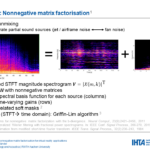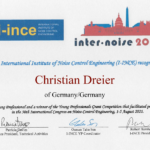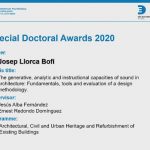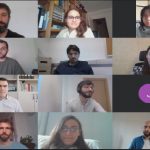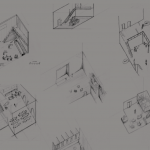Kategorie: ‘Events’
Promotionsprüfung Thiago Lobato
Am 12.04.2024 hat Herr Thiago Lobato seine Promotionsprüfung zum Thema „Improving sound source localization and characterization with machine learning techniques“ erfolgreich abgeschlossen.
Das IHTA gratuliert herzlich!
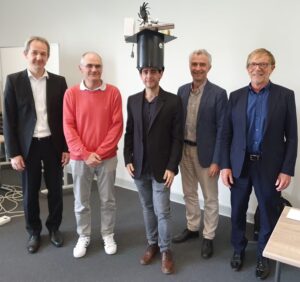
Bild: Julian Becker/Roland Sottek
junge DEGA Herbstworkshop 2023 in Aachen
From 17th to 19th November 2023, the “junge DEGA Herbstworkshop” (autumn workshop) took place in Aachen. Junge DEGA is a section of the German Acoustical Society (DEGA) and partner of the Young Acousticians Network (YAN) of the European Acoustics Association (EAA). Its mission is to connect students, PhDs and young professionals in the domain of acoustics. The group organizes special sessions and panel discussions during the Annual German Conference on Acoustics (DAGA), providing information on research opportunities and job entry. Furthermore, junge DEGA offers a mentoring program with active participation from industry and academia.
The workshop started on Friday afternoon with a visit of HEAD Acoustics GmbH in Kohlscheid, where the participants got insights into the company’s research and development activities and experienced some hands-on demonstrations of new products. After this first visit, three RWTH spin-offs – FEV, KLANG, elevear – reported on their experiences in business practice and illustrated different career paths in the field of acoustics. The first day concluded with a meeting of the group resuming the year’s activities and discussing the plans for the upcoming conference DAGA 2024.
On Saturday, the participants visited four laboratories at RWTH Aachen University. The day started with a welcoming tour at the Institute for Hearing Technology and Acoustics (IHTA) with demonstrations of the room acoustics simulation software RAVEN, experiments for audio-visual perception studies and the SCaLAr loudspeaker array. The Institute for Automotive Engineering (ika) opened the doors to their semi-anechoic climate chamber and to a broad range of tire test rigs, which are used to determine the dynamic load during tire-road contact under the influence of different road surfaces. The Experimental Behavioral Psychobiology group & Brain Imaging Facility at RWTH University hospital presented research in which specific acoustic stimuli are used during magnetic resonance imaging to better understand the auditory processing with schizophrenia. Finally, the III. Physics Institute B presented its research on a sonar- and radar-equipped melting probe which aims to penetrate the ice shield and explore the subglacial ocean of the Jovian moon Europa (TRIPLE). Another project focused on the use of acoustic measurements to calibrate the neutrino observatory IceCube.
The weekend concluded with a hands-on workshop on binaural synthesis and virtual acoustics applications (see virtualacoustics.org) at IHTA.
Thanks to all participants and supporters!
- III. Physics Institute B, Photo: Jonas Heck
- Brain Imaging Facility at RWTH University hospital, Photo: Jonas Heck
- Institute for Automotive Engineering (ika), Photo: Olaf Uszynski
- Hands-on workshop at IHTA, Photo: Pascal Palenda
Aachen Acoustics Colloquium 2023
Next week the 14th Aachen Acoustics Colloquium will take place at Parkhotel Quellenhof in Aachen. On Tuesday, November, 28th and Wednesday, November, 29th, the scientific program includes 22 interesting presentations about current research within the area of automotive acoustics, accompanied by a technical exhibition from various companies and research institutes. A detailed overview of the program can be found in this PDF.
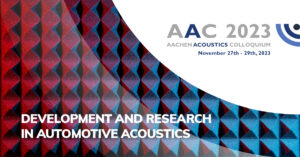
Our Institute contributes to two presentation to this conference:
- Mark Müller-Giebeler: “FE-Based Inverse Approach to Determine Complex Acoustic Material Parameters in Alpha Cabins”
- Chalotorn Möhlmann: “Holistic Approach for Aurally Accurate Road Traffic Noise Reduction by Adaption of Traffic Routes and Infrastructure Planning” (together with Carolin Schliephake, part of the BalSaM project)
Registration for the on-site participation this event is no longer available, but the registration for online participation is still possible on the AAC website.
DAGA 2024 Travel Grants
Die Gesellschaft für Technische Akustik (GfTA e.V.) möchte Studierende des IHTAs unterstützen an der kommenden Jahrestagung für Akustik (DAGA 2024) teilzunehmen. Diese findet vom 18. bis zum 21. März 2024 in Hannover statt und bietet eine sehr spannende Möglichkeit, erste Erfahrungen bei wissenschaftlichen Konferenzen zu sammeln.

Die GfTA fördert in diesem Jahr zwei Studierende mit einen Reisezuschuss (Travel grant) in Höhe von jeweils 250€. Kandidat*innen müssen keinen wissenschaftlichen Beitrag bei der Konferenz einreichen, sollten aber zuvor noch keine DAGA-Konferenz besucht haben und an mind. einer Lehrveranstaltung am IHTA teilgenommen oder eine Abschlussarbeit angefertigt haben / aktuell anfertigen.
Um Dich für den Travel grant zu bewerben, schreibe eine Email an Lukas Aspöck und erkläre in ein oder zwei Sätzen, warum Du motiviert bist an einer Akustik-Konferenz teilzunehmen. Die Deadline für Bewerbungen ist der 14.12.2023, die Bekanntgabe findet bei der IHTA-Weihnachtsfeier am 19.12.2023 statt.
junge DEGA Herbstworkshop 2023 – Ankündigung
Die Fachgruppe „junge DEGA“ der Deutschen Gesellschaft für Akustik e.V. (DEGA) veranstaltet regelmäßig einen Herbstworkshop mit dem Ziel, junge Akustikerinnen und Akustiker (Studierende, Promovierende, Young Professionals) zu vernetzen und persönlichen Austausch zu ermöglichen. Der diesjährige Herbstworkshop wird organisiert durch die aktuelle Leitung der Fachgruppe (Simon Kersten und Jonas Heck) mit Unterstützung weiterer Kolleg:innen des IHTA. Der Workshop findet vom 17.-19. November 2023 in Aachen statt.
Auf dem Programm des Herbstworkshops steht:
- Besuch des Instituts für Hörtechnik und Akustik (IHTA) an der RWTH Aachen, inkl. „Hands-On“-Workshop zur virtuellen Akustik
- Austausch zu Fach- & Promotionsthemen der Teilnehmenden
- Besuch weiterer Forschungseinrichtungen an der RWTH & Industriepartner
- Sitzung der junge DEGA-Fachgruppe
Anmeldung und Details zum Programm: https://www.dega-akustik.de/junge-dega/projekte (Anmeldeschluss: 31.10.2023).
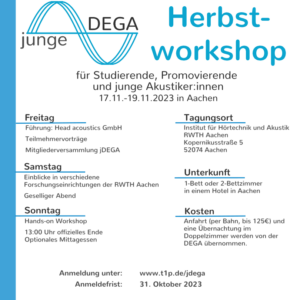
Research trip to Santiago de Chile
From October 10th to October 13th 2023, Lukas Aspöck participated in the workshop “Digital transformation in the development of rehabilitation sciences: the current challenge to use state-of-the-art technology” on behalf of the Institute for Hearing Technology and Acoustics.
The workshop was held in Santiago de Chile and Valparaíso and was mainly hosted and organized by the Universidad San Sebastián. The program included many interesting presentations by national and international researchers related to machine learning, virtual reality and the development of sensors and tools which can be applied within different fields of rehabilitation and related research. As part of the workshop, the researchers also visited various facilities, ranging from laboratories and workshops for speech therapy and audiology to a healthcare unit for physical rehabilitation and the research and technology transfer center AC3E of the Federico Santa María Technical University.
- Visit at the AC3E research center, Valparaiso Photo: Sandra Rojas
- The organisation team of the event Photo: Lukas Aspöck
- Lukas during his presentation Photo: Rhoddy Viveros
- Speech lab in AC3E center in Valparaiso Photo: Lukas Aspöck
Lukas contributed to the event by giving a 60-minute presentation with the topic “Virtual reality environments for research in acoustics and audiology”. The slides of this presentation are available here.
Many thanks to our former colleague Rhoddy Viveros for the organization and the invitation to this event. Thanks also to the rest of the organization team, which was led by Carla Contreras and also included Sandra Rojas, Matías Zañartu and Cristhian Mendoza. The event was funded by the Chilean National Research and Development Agency (International Linkage FOVI220126).
Jahrestagung der Gesellschaft für Musikforschung 2023
Im Rahmen der Jahrestagung der Gesellschaft für Musikforschung 2023 in Saarbrücken fand am 5. Oktober 2023 ein Marktplatz aktueller Forschung statt, in der Methoden und Werkzeuge für die digitale Musikforschung präsentiert werden konnten. Im Zuge der Zusammenarbeit mit Prof. Stefan Morent von der Universität im Projekt „Sacred Sound – Sacred Space“ demonstrierten unsere Mitarbeitenden Carolin Breuer und Pascal Palenda die Möglichkeiten, Räume akustische zu simulieren und auralisieren, in virtuelle Räume hinzusingen oder zu musizieren, sowie Räume in der Virtuellen Realität mit Hilfe eines Head-Mounted-Displays interaktiv akustisch-visuell erlebbar zu machen.
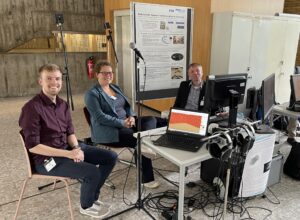
Stand bei der Jahrestagung für Musikforschung. Foto: Martin Albrecht-Hohmaier
60 Jahre I(H)TA- Fest
Am Samstag, den 19. August 2023 wurde das 60-jährige Bestehen des IHTA/ITAs gefeiert.
Das Institut für Technische Akustik wurde nach einer Übergangphase ab 1961 offiziell am 2.1.1964 mit Prof. Dr. Wilhelm Janovsky als erstem Leiter gegründet. Es folgten 1972 Prof. Dr. Heinrich Kuttruff, 1996 Prof. Dr. Michael Vorländer und schließlich seit 2020 Prof. Dr.-Ing. Janina Fels als Leitung des heutigen Instituts für Hörtechnik und Akustik.
Über 120 Ehemalige und Aktive des Instituts nahmen an der Feier mit Führungen und Demonstrationen aktueller Forschungsthemen und natürlich am Essen, Getränken und Live-Musik der IHTA-Band teil.
Ein besonderer Dank gilt hier der Gesellschaft für Technische Akustik e.V. (GfTA), die diese Feier ermöglicht hat. Wer noch nicht Mitglied im Verein ist, kann dies hier (Beitrittserklärung) werden, damit wir auch weiterhin das Netzwerk aus Ehemaligen und Aktiven und dem Nachwuchs in der Akustik unterstützen und pflegen können.
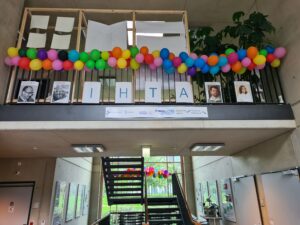
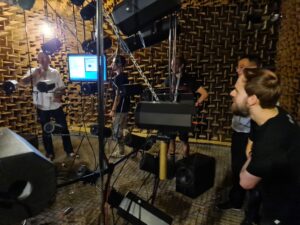
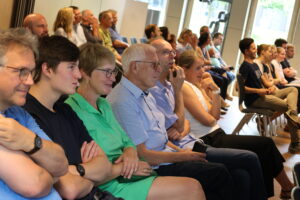
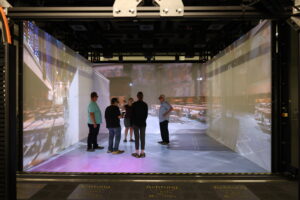
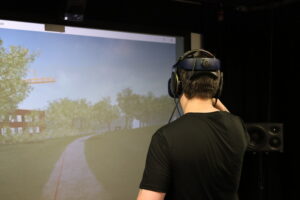

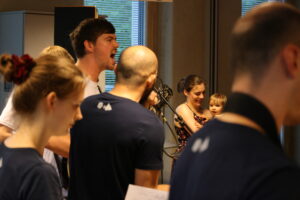
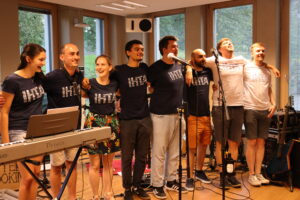
1st IHTA Retreat
An interchange for good teamwork between researchers
On 28th and 29th March 2023, the scientific staff of IHTA was on a retreat at Gut Hohenholz near Bedburg in the Rhein Erft Kreis. During these two days, the institute’s past was reflected, and it was discussed how the future of the IHTA can be shaped together. Moreover, there was an intensive exchange among each other’s scientific work in the form of poster sessions. The researchers presented each other’s projects and revealed which milestones needed to be reached to achieve specific goals. Between poster sessions team spirit was strengthened, and the future of teaching and workflows were addressed. Furthermore, it was discussed how the skills of individual researchers could be maintained and passed on to new staff members.
Overall, it was two successful days with a lot of input for each individual and a lot of output for the group at IHTA.
A big thank you to Joachim Bellut, who guided us through the two days with his great moderation!
- Group photo at the IHTA Retreat (Foto: Joachim Bellut)
- Poster session (Foto: Joachim Bellut)
- Poster session (Foto: Joachim Bellut)
- Team building task (Foto: Joachim Bellut)
DAGA 2023 – 49. Jahrestagung für Akustik
Again, IHTA is joining DAGA in Hamburg with interesting contributions from March, 6th, to March, 8th, 2023. We are delighted to invite to our presentations and posters. In total, IHTA members will be represented with 27 contributions (22 presentations and 5 posters):
| Presentations | ||||
|---|---|---|---|---|
| Tuesday, March 7th | ||||
| Jonas Heck, Josep Llorca-Bofí, Aakriti Jain, Michael Vorländer |
Text mining of audio-visual descriptors for concert halls | Raumakustik 1 – Qualitätsfragen und Fallstudien A | 14:00 | Saal X 1-2 |
| Lukas Vollmer, Elisabeta Balla, Björn Kampa, Janina Fels | The Auditory Mismatch Negativity as an EEG-derived Measure of Predictive Coding | Psychoakustik | 14:20 | Saal X 7-8 |
| Lukas Aspöck, Michael Vorländer, Anne Heimes, Andreas Herweg, Olivier Dazel |
An online course about acoustic simulations and auralization | Lehre der Akustik | 15:00 | Saal Y 4 |
| Shaimaa Doma, Cosima Ermert, Janina Fels |
On the monaural contribution to HRTF discrimination | Perceptual Optimization of Dynamic Binaural Rendering 2 | 16:40 | Saal Y 9 |
| Lara Stürenburg, Hark Braren, Lukas Aspöck, Janina Fels | Akustische Vermessung einer Wärmepumpe für Hörexperimente und Simulationen | Strömungsakustik in der Energiewende | 17:20 | Saal X 9-10 |
| Wednesday, March 8th | ||||
| Marco Berzborn, Michael Vorländer | Analytic Model Based Analysis of Modal Sound Field Decay | Raumakustik 2 – Messung und Simulation A | 09:00 | Saal X 1-2 |
| Thomas Deutsch, Janina Fels | Evaluating Models for the Simulation of Cochlear Hearing Loss | Audiologische Akustik 3 – Charakterisierung des Hörsystems | 10:00 | Saal Y 5 |
| Pascal Palenda, Michael Kohnen, Michael Vorländer |
Influence of Position Mismatch on the Perception of Early Reflections of One’s Own Voice | Virtuelle Akustik 1 | 10:40 | Saal X 11-12 |
| Karin Loh, Edina Fintor, Sophie Nolden, Janina Fels | Comparing Children’s and Adults’ Intentional Switching of Auditory Selective Attention in Spatial and Noisy Acoustic Environments | Psychoakustik | 14:00 | Saal X 7-8 |
| Julia Seitz, Karin Loh, Sophie Nolden, Janina Fels | Investigating Intentional Switching of Spatial Auditory Selective Attention in an Experiment with Preschool Children | Psychoakustik | 14:20 | Saal X 7-8 |
| Hark Braren, Janina Fels | Individualized Head-related Transfer Functions for Children | Virtuelle Akustik 3 | 16:40 | Saal X 11-12 |
| Mark Müller-Giebeler, Michael Vorländer | Präzise Modellierung diffuser Schallfelder zur inversen Bestimmung akustischer Materialparameter | Raumakustik 2 – Messung und Simulation B | 17:40 | Saal X 1-2 |
| Anne Heimes, Michael Vorländer |
Measurement setup design for scattering patterns based on numerical simulations | Raumakustik 2 – Messung und Simulation B | 18:20 | Saal X 1-2 |
| Ingo Witew, Michael Vorländer | Wie genau müssen Messpositionen für reproduzierbare Klarheitsmaß Messungen definiert werden? | Raumakustik 2 – Messung und Simulation B | Saal X 1-2 | |
| Thursday, March 9th | ||||
| Chinthusa Mohanathasan, Jonathan Ehret, Cosima A. Ermert, Janina Fels, Torsten W. Kuhle, Sabine J. Schlittmeiers |
Towards More Realistic Listening Research in Virtual Environments: The Effect of Spatial Position of Two Talkers in Conversations on Memory and Listening Effort | SPP2236 – Auditory Cognition in Interactive Virtual Environments 1 | 09:20 | Saal Y 5 |
| Josep Llorca-Bofí, Jonas Heck, Michael Vorländer |
Reproducibility Exploration of Individual Vocabulary Profiles on Urban Soundscapes: Driescher Hof, Aachen | Soundscape | 09:40 | Saal X 5-6 |
| Cosima A. Ermert, Jonathan Ehret, Torsten W. Kuhlen, Chinthusa Mohanathasan, Sabine J. Schlittmeier, Janina Fels |
Audio-visual content mismatches in the serial recall paradigm | SPP2236 – Auditory Cognition in Interactive Virtual Environments 1 | 09:50 | Saal Y 5 |
| Chalotorn Möhlmann, Simon Kersten, Michael Vorländer |
Finite Element Simulation of the Occlusion Effect in the Ear Canal | Assisted Hearing – Testing, Models, Quality 1 | 10:00 | Saal X 11-12 |
| Lukas Aspöck, Stefan Morent, Michael Vorländer | Simulated reverberation for choir recordings in virtual churches | Raumakustik | 10:20 | Plenarsaal |
| Simon Kersten, Henning Taschke, Michael Vorländer | Fluid Motion and Pressure Distribution in the Human Inner Ear during Bone Conduction Hearing | Assisted Hearing – Testing, Models, Quality 1 | 10:20 | Saal X 11-12 |
| Carolin Breuer, Stephan Fremerey, Larissa Leist, Maria Klatte, Alexander Raake, Janina Fels |
Investigating the Influence of Visual Distractors on the Voluntary Switchtig of Auditory Selective Attention in Virtual Reality | SPP2236 – Auditory Cognition in Interactive Virtual Environments 1 | 10:40 | Saal Y 5 |
| Elie Abi Raad, Jose Maria Gomez Belmonte, Michael Vorländer |
Frequency response characterization of the welding process in Ultrasonic Metal Welding | Structure-borne sound | 16:00 | Saa Y6 |
| Poster | ||||
| Wednesday, March 8th | ||||
| Stefan Winkelmann, Lara Stürenburg, Isabel S. Schiller, Janina Fels, Sabine J. Schlittmeier |
Subjektiver akustischer Komfort von Luftdurchlässen für Gebäudelüftungen | Psychoakustik | 15:40-16:20 |
Foyer Z, Posterinsel H |
|
Marco Wegener, Jonas Heck, Josep Llorca-Bofí, Rouben Rehman, Christian Dreier, Philipp Schäfer, Michael Vorländer |
Introducing an Unreal Engine toolkit for audio-visual perception studies in the virtual lab IHTApark | Virtuelle Akustik (Late Poster) |
15:40-16:20 |
Foyer Z, Posterinsel Q |
| Thursday, March 9th | ||||
| Frederike Rust, Karin Loh, Lukas Aspöck, Janina Fels | Auswirkung akustischer Maßnahmen auf das Lärmempfinden im Klassenraum | Raumakustik (Late Poster) |
11:00-11:40 | Foyer Z, Posterinsel R |
| Jianliang Gao, Ingo Witew, Lukas Aspöck, Michael Vorländer, S. K. Tang | Global sound field estimation of a theatre using an efficient multi-channel room acoustic measurement system | Raumakustik (Late Poster) |
11:00-11:40 |
Foyer Z, Posterinsel R |
| Lili Pan, Jianliang Gao, Yuezhe Zhao | An optimized procedure for random-incidence scattering coefficient measurement in 1:10 scaled reverberation room | Raumakustik (Late Poster) |
11:00-11:40 |
Foyer Z, Posterinsel R |
An overview of all contributions and updated information can be found in the DAGA 2023 App.
We are looking forward to seeing you at DAGA 2023!
IHTA at the BauSIM conference in Weimar
From the 20th to the 22nd September 2022, the BauSIM conference took place. The scientific core topic of the conference is traditionally the energetic simulation in the building sector and offers an ideal discussion forum for experts from science and industry for mutual exchange. The conference is organized by the and IBSPA Germany-Austria, member of the International Building and Performance Simulation Association (IBPSA) This year’s conference introduced a new session on acoustic simulation topics, and our institute was present.
In particular, our Junior Principal Investigator Dr. Josep Llorca-Bofí, from the PAAD group was invited as key-note speaker, talking about The city – A machine for noise? Virtual acoustics in architectural design research. Together with our PhD student M. Sc. Jonas Heck and Professor Michael Vorländer, the following research paper was presented: 3D photogrammetry for auralization – An approach for geometry simplification and material categorization.
- Key-note talk Dr. Josep Llorca-Bofí
- Bauhaus-Universtät Weimar
- BauSIM lecture hall
- IHTApark demonstrator
- Immersive audio and visuals
- Portable research laboratory using head-mounted display and equalized headphones
- Visit to the acoustic laboratory at the chair of Building Physics
- Visit to the acoustic laboratory at the chair of Building Physics
- Optic visualization of thermal air movement
- Visit to the optics laboratory at the chair of Building Physics
junge DEGA Workshop 2022 in Stuttgart
From 2nd to 4th September 2022, after a three-years break due to the Covid-19 pandemic, the “junge DEGA Herbstworkshop” took place in Stuttgart, like the DAGA conference earlier this year. Junge DEGA is a sub-group of the German Acoustical Society with the mission to connect students, PhDs and young professionals in the domain of acoustics. It organizes special sessions and panel discussions during the Annual German Conference on Acoustics (DAGA), providing information on research funding opportunities and job entry. Furthermore, junge DEGA offers a mentoring program with active participation from industry and academia.
Two PhD students of the Institute for Hearing Technology and Acoustics, Simon Kersten and Jonas Heck, as well as Nils Rummler, recently graduated bachelor student, participated in this year’s workshop. The program started with visits at the Fraunhofer Institute for Building Physics IBP and the Center for Building Physics (ZfB, Hochschule für Technik Stuttgart). Furthermore, it consisted of short presentations given by the participants, a plenary meeting of the junge DEGA group to plan the following year’s activities and a guided visit of the new main station construction site (known as Stuttgart 21) with a focus on noise and vibration control. The weekend was concluded with a hands-on workshop on building a loudspeaker from residual materials and competing for the highest sound pressure level.
Pictures from the workshop can be found in the gallery below.
- Participants of the junge DEGA Herbstworkshop 2022
- Loudspeaker competition
- Loudspeaker competition
- Loudspeaker competition
- Visit of the Stuttgart21 construction site
Promotionsprüfung Muhammad Imran, M.Sc.
Am 4. Februar 2022 hat Herr Muhammad Imran seine mündliche Promotionsprüfung erfolgreich abgeschlossen.
Herr Muhammad Imran promovierte über das Thema:
„Virtual Building Acoustics – Auralization with contextual and Interactive Features“
Abstract:
Building acoustics auralization is used to assess the perceptual aspects of sound transmission in built environments to provide the guidelines for architectural constructions and to evaluate the noise effects on humans. These noise effects have a negative influence on daily-life activities and create disturbances in physical and metal work. These disturbances are present within the dwellings and/or might be from outdoor moving transient sound sources. Methods are available for auralization of sound insulation between connected rooms in compliance with the standardized data formats of sound insulation metrics and building structural geometries. However, there still exist certain challenges to be addressed to construct the transfer functions between noise sources and receiver room for indoor situations as well as for the outdoor moving sound sources and to make these sources audible through audio-visual virtual reality systems in real time and interactively. These challenges are due to certain simplifications which are implicit in the formulation on which the sound insulation prediction models are based, such as, diffuse field assumptions, neglecting source characteristics, and source and receiver room acoustics.
This thesis focuses on addressing the present challenges in the traditional sound insulation rendering techniques and establishing an interface between psychoacoustic research and building acoustics in dwellings (especially airborne sound insulation) integrated with audio-visual virtual reality environments. From the technical perspective, improvements are made in sound insulation prediction methods, and corresponding filter construction and rendering techniques for auralization. In the first place, the building elements are considered as multitude of secondary sources rather than taking them as point source radiators and the bending wave patterns are addressed in order to be able to properly construct the transfer functions from source to the receiver room. Secondly, the room acoustical simulations are carried out for both source and receiving rooms to generate transfer functions from source to the source room walls and from radiating receiving room walls to the listener, so that the geometries and absorption might be fit to the properties desired by the user for the spatial impression of the listening rooms. In addition, the transfer functions from radiating walls of the receiving room to listener are designed in such a way that not only indoor sources are handled nevertheless the outdoor moving sources are also addressed.
Some important conditions are associated with virtual building acoustics auralization research platform for advanced studies of noise effects in dwellings which are addressed. The audio files, generally, used in listening tests are arbitrarily manipulated by audio samples without the background of a physical model of the built environments. They must comply with the standardized data formats of sound reduction indices (level differences) and/or sound transmission coefficients. Other data related to building structure such as geometry shall be strictly connected to the architectural design, the building materials and constructions. Otherwise the conclusions of the psychoacoustic experiments have no direct correlation with the architectural design, especially when presented through virtual environments. To achieve this, the auralization framework is extended toward real-time interactive audio-visual technology, i.e. VR technology, in order to be able to introduce more realism and, hence, contextual features into psychoacoustic experiments. The building acoustics framework is validated by taking indoor and outdoor example case studies. Listening experiments close to real-life situations are carried out by using this framework to show that this framework can be used as an alternate to design new test paradigms which help to better analyse and interpret the noise impact in building situations depending on the actual activity such as working, learning, and rest.
Das IHTA gratuliert sehr herzlich!!
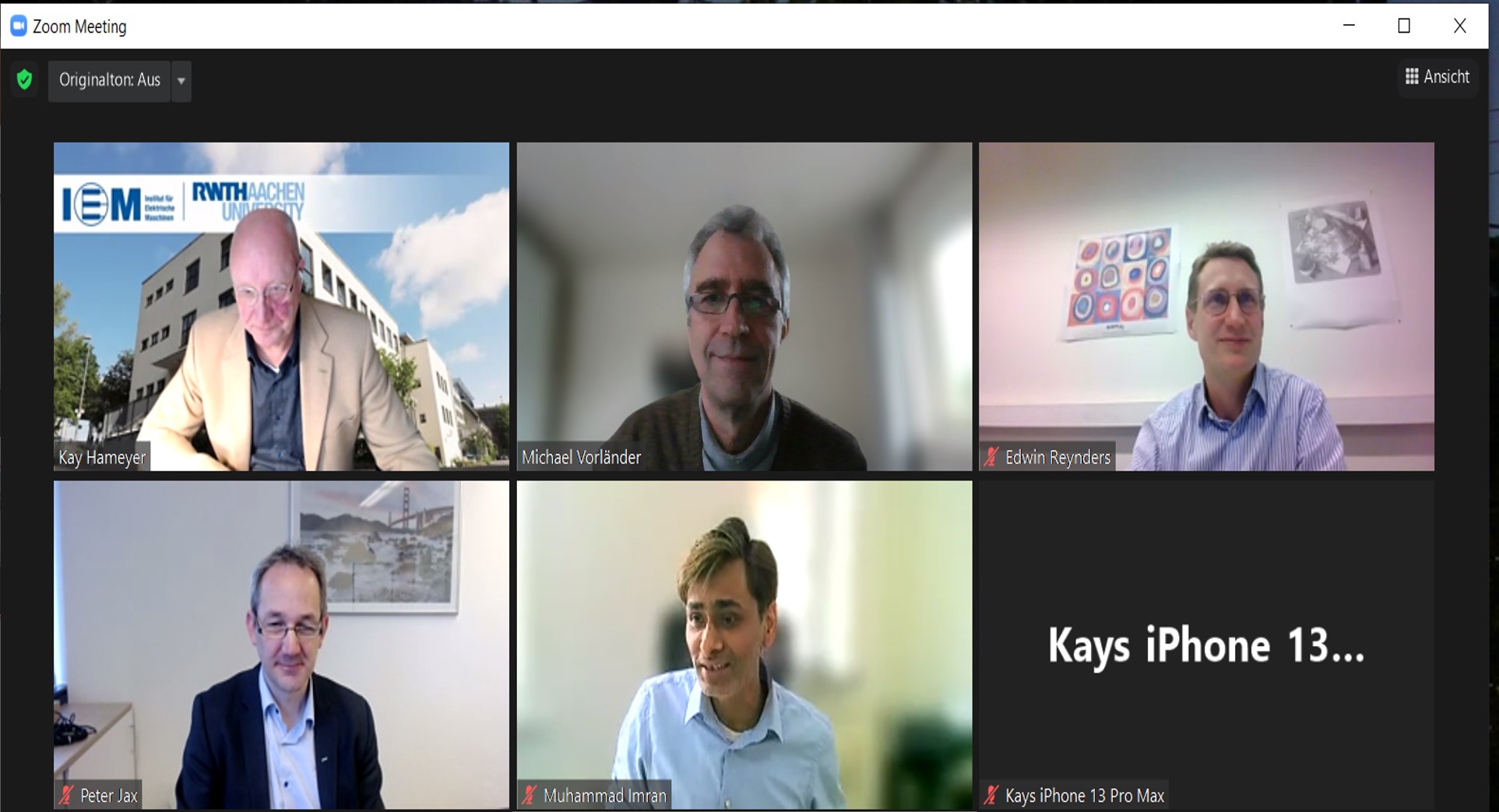
Doctoral exam Muhammad Imran, Examination committee: Prof. Dr. Kay Hameyer, Prof. Dr. Michael Vorländer, Prof. Dr. Edwin Reynders, Prof. Dr. Peter Jax
Promotionsprüfung Dipl.-Ing. Ingo Witew
Am 21. Januar 2022 hat Herr Ingo Witew seine mündliche Promotionsprüfung erfolgreich abgeschlossen.
Herr Witew promovierte über das Thema:
„Measurements in room acoustics – Uncertainties and influence of the measurement position“
Abstract:
Regardless of the field, measurements are essential for the validation of theories and for making well-founded decisions. A criterion for the validity and comparability of measured values is their uncertainty. The „Guide to the Expression of Uncertainty in Measurement“ (GUM) provides a standardized framework for determining and interpreting measurement uncertainty. In room acoustic measurements, the application of these rules is not yet widespread. On the one hand, this is due to the fact that well established 2-CH-FFT correlation techniques rely on a complex principle, which is not covered by the classical guide. In addition, the effect of input variables on a measurement can only be determined in individual cases after considerable effort. An example are fluctuations of room acoustic quantities over smallest distances between measurement locations in concert halls. This change of the sound field over the location is sometimes considerable and can only be predicted in relatively simple boundary value problems. This raises the question of the validity and interpretability of room acoustics measurements.
The goal of this thesis is to provide a GUM-compliant discussion of uncertainties in measuring room acoustic single-number quantities. This starts with a structured search of variables that potentially influence the measurement of room impulse responses. In a second step, this uncertainty is propagated through the algorithm for determining room acoustic single-number quantities.
Further emphasis is placed on the investigation of spatial fluctuations of the sound field in auditoria. The influence of an uncertain measurement position on the overall measurement uncertainty is discussed. To reach general conclusions, the relation between changes in the measurement location and the corresponding changes in room acoustics quantities is investigated empirically in extensive measurement series. To this purpose, a measurement apparatus was designed that allows automatic, high-resolution sampling of sound fields over large areas. The collected data sets the foundation to propagate the uncertainty using a Monte Carlo method.
This study shows how precisely a measurement position must be defined to ensure a given uncertainty of room acoustical single-number quantities. The presented methods form a foundation that can be flexibly extended in future investigations to include additional influences on the measurement uncertainty.
Das IHTA gratuliert sehr herzlich!!

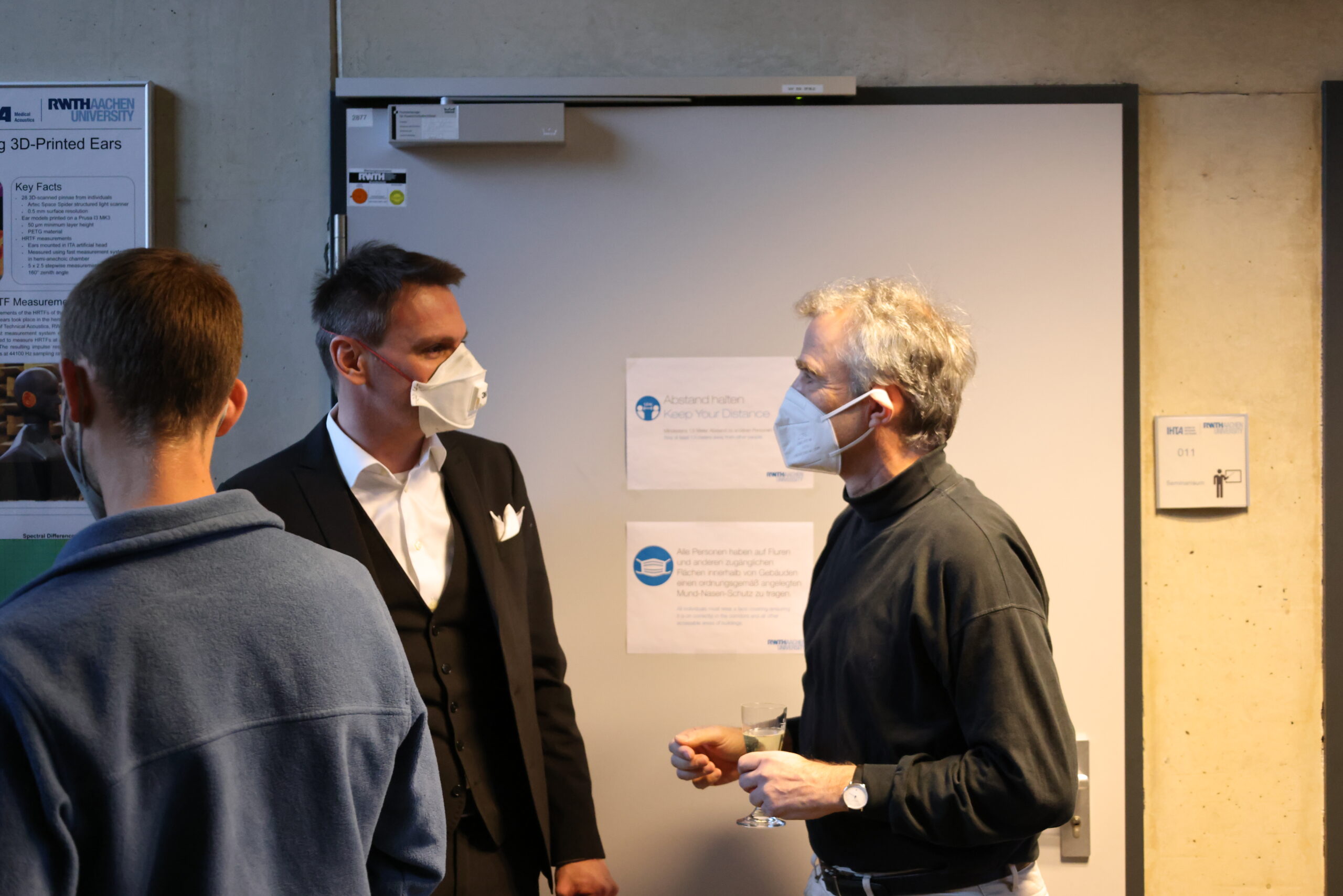
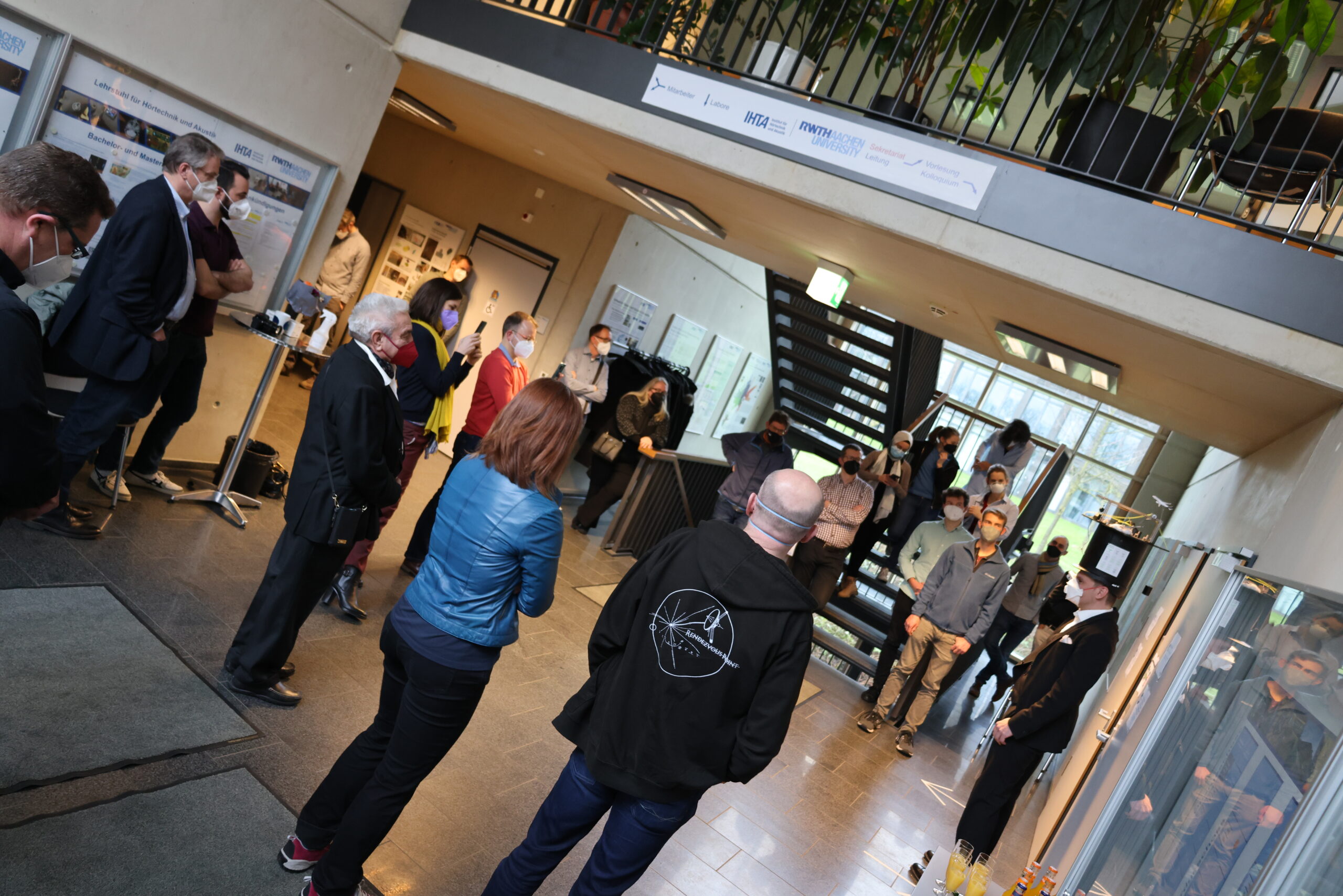
Fotos: Josep Llorca-Bofí
Promotionsprüfung Dipl.-Ing. Florian Pausch
Am 26. November 2021 hat Herr Florian Johannes Pausch seine mündliche Promotionsprüfung erfolgreich abgeschlossen.
Herr Pausch promovierte über das Thema: „Spatial audio reproduction for hearing aid research: System design, evaluation and application“
Abstract:
Listening, understanding and communicating are essential skills for social interaction in everyday life. Hearing loss (HL) may have severe consequences on these skills and affect individuals by hindering language development, learning success and participation in social life already at an early age. Depending on the individual predisposition, those affected are likely to withdraw from socialisation processes and sometimes suffer from compromised mental and general health. However, these consequences are not limited to children but also apply to adults and elderly people, especially those who refuse to acknowledge their HL and appropriate treatment, leading to an increased risk of apathy and depression, as well as memory problems and dementia. Assistive listening devices, such as hearing aids (HAs), represent an effective technical intervention tool capable of partially restoring impaired hearing and helping to overcome the aforementioned consequences of HL. Despite using the latest technology, individuals fitted with HAs often complain about poor performance of their devices, particularly in demanding indoor communication settings with unfavourable room acoustics. To some extent, these performance shortcomings can be attributed to limitations of HA algorithms, which are often designed and tested using simplified laboratory scenarios that may differ substantially from complex real-world situations. This thesis contributes to bridging this gap by exploring the advantages and flexibility of virtual acoustic environments (VAEs) reproduced by state-of-the-art spatial audio reproduction methods adapted for HA research. In order to further approach the overarching goal of ecological validity, the system design has been complemented by real-time implementations and room acoustic simulations, allowing to include listener movements via motion tracking and simulate plausible indoor environments, respectively. The systems are comparatively evaluated based on measurements and perceptual experiments with normal-hearing individuals, demonstrating their applicability in experiments involving normal-hearing participants and participants with HL.
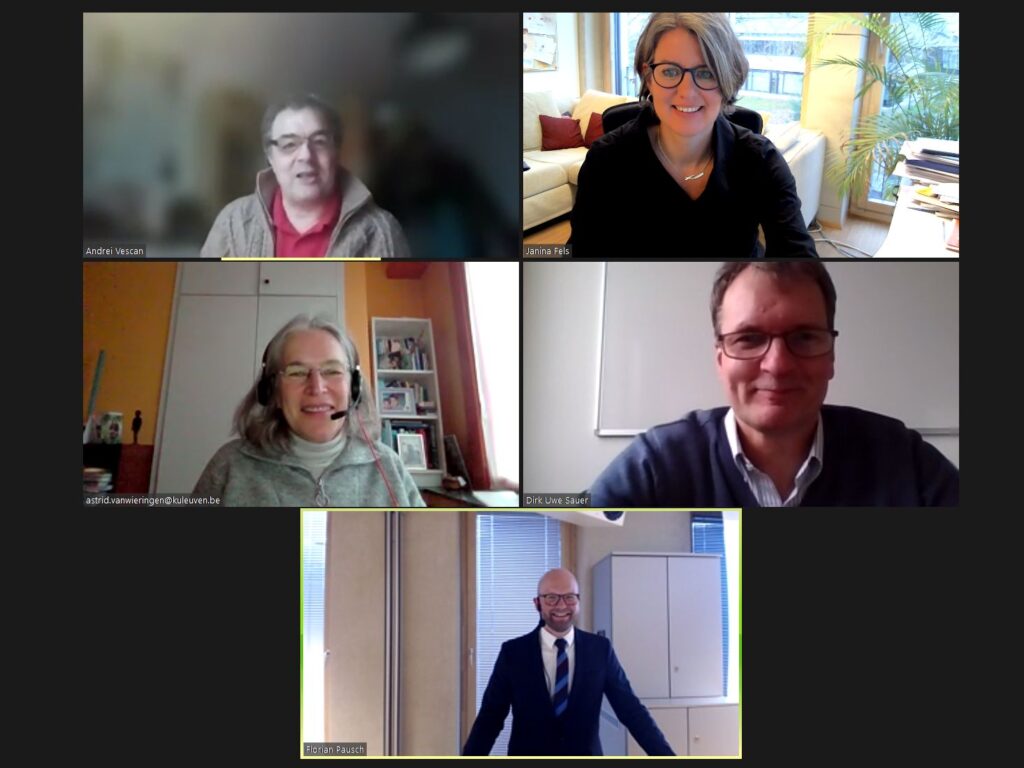
Doctoral exam Florian Pausch, Prüfungskommission: Zweitgutachterin Prof. Dr. Astrid van Wieringen (KU Leuven), Prof. Dr. Andrei Vescan, Prof. Dr. Dirk Uwe Sauer, Prof. Dr. Janina Fels
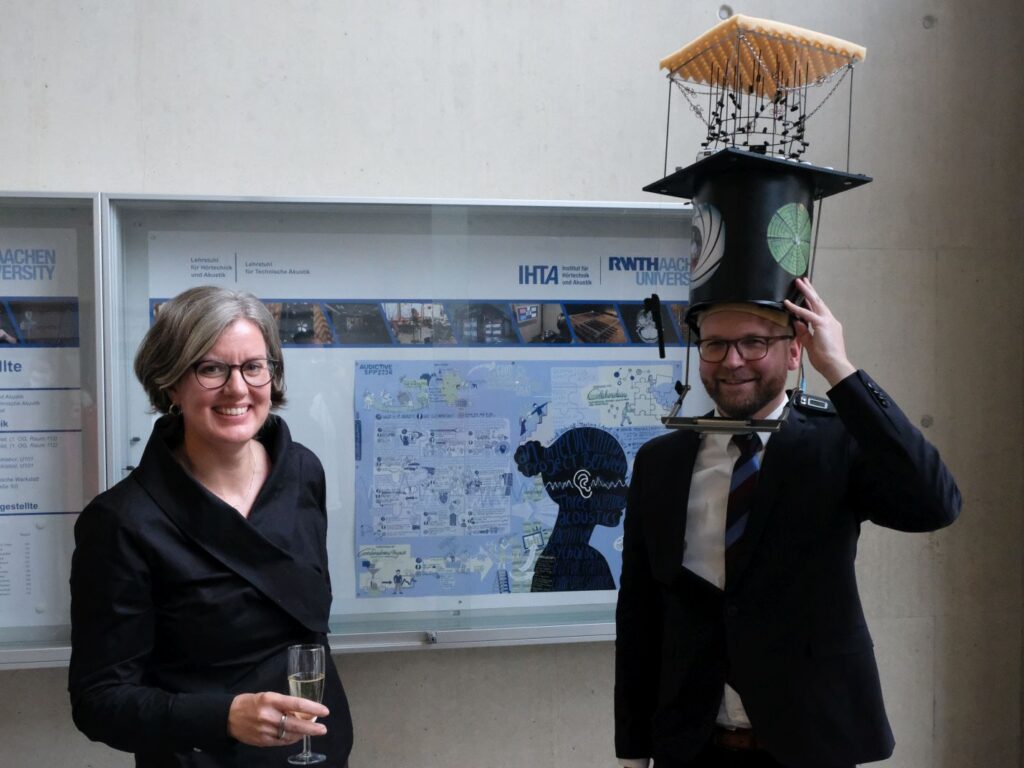
Doktorprüfung Florian Pausch. Prof. Dr.-Ing. Janina Fels und Dipl.-Ing. Florian Pausch. Foto: Mark Müller-Giebeler
Das IHTA gratuliert sehr herzlich!!
Young Professionals Grant at inter-noise 2021
From August 1st, 2021 until August 5th, 2021, the 50th International Congress and Exposition on Noise Control Engineering (inter-noise 2021) was held in online mode (originally it was planned to take place in Washington, DC).
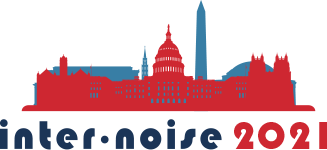
Our PhD student Christian Dreier participated in this event and presented the paper Sound source modelling by nonnegative matrix factorisation for virtual reality applications. Related to this contribution, he was selected as a winner of the Young Professionals Grant Competition by the Institute of Noise Control Engineering (I-INCE) – congratulations to Christian for this award!
- Remote sensing of aircraft noise
- Source separation
- Certificate of the award
DAGA 2021 – Die Jahrestagung für Akustik
Nachdem im Jahr 2020 die in Hannover geplante DAGA-Tagung ausfallen musste, wurde die DAGA 2021 in den Monat August geschoben. Die Hoffnung, dass die Pandemie die Tagungsdurchführung nichtmehr beeinflusst, hat sich nicht erfüllt, aber immerhin kann die in Wien, vom 15. August bis zum 18. August 2021, stattfindene Konferenz als Hybrid-Veranstaltung durchgeführt werden, d.h. eine Teilnahme ist sowohl vor Ort, als auch Online möglich. Aufgrund der Anweisung der RWTH Aachen, Dienstreisen soweit es geht zu vermeiden, nehmen alle IHTA-Beschäftigten online an der Tagung teil und verzichten somit auf die Reise nach Wien.
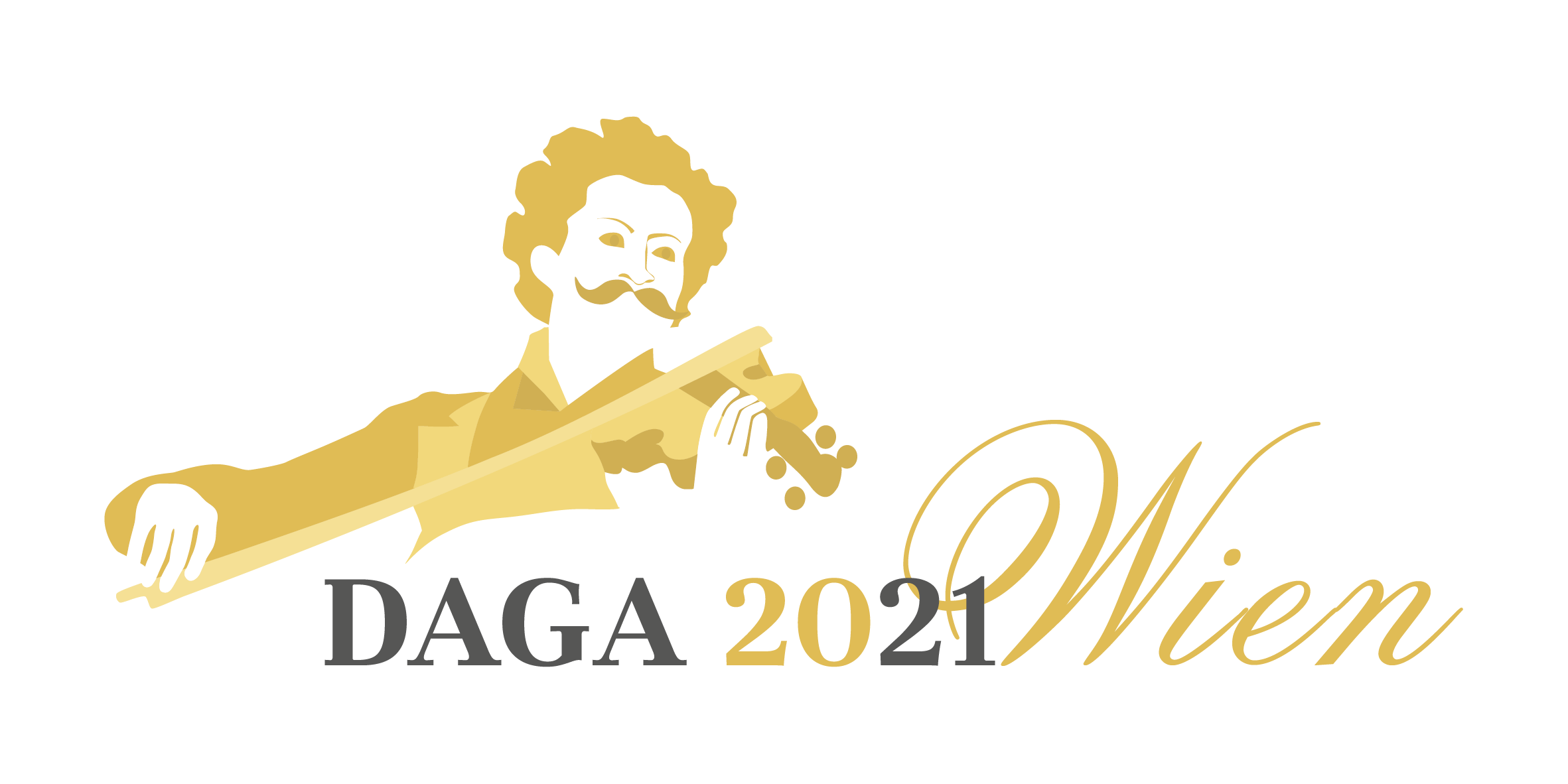
Die Tagung beginnt am Sonntag mit drei Vorkolloquien, die meisten Sitzungen finden jedoch an den drei Haupttagen von Montag bis Mittwoch statt. Insgesamt ist das Institut für Hörtechnik und Akustik an 27 wissenschaftlichen Beiträgen beteiligt (21 Vorträge und 6 Poster).
Vortrag am Montag:
| Jonathan Ehret, Lukas Aspöck, Andrea Bönsch, Janina Fels, Torsten W. Kuhlen | Speech Source Directivity for Embodied Conversational Agents |
Vorträge am Dienstag:
Vorträge am Mittwoch:
Poster:
| Marco Berzborn, Fabian Brinkmann, Simon Kersten, Kai Jurgeit | pyfar: Python Packages for Acoustics Research |
| Anne Heimes, Michael Vorländer | A framework to conduct psychoacoustic experiments in virtual reality |
| Jonas Heck, Josep Llorca-Bofí, Michael Vorländer | Hearing Architecture and Seeing Soundscapes: Methodological Approach of Individual Vocabulary Profiling to Evaluate Audiovisual Perception |
| Lukas Aspöck, Jonathan Ehret, Stefan Baumann, Andrea Bönsch, Christine T. Röhr, Martine Grice, Torsten W. Kuhlen, Janina Fels | Prosodic and visual naturalness of dialogs presented by conversational virtual agents |
| Isabel Schiller, Jan Alber, Lukas Aspöck, Chinthusa Mohanathasan, Linda Wetzel, Sabine Schlittmeier | Text-related immersion for varying auditory background scenes |
| Karin Loh, Julian Burger, Lukas Aspöck, Janina Fels | EduRA database: room models based on room acoustic measurements in primary and preschools |
Eine Übersicht über alle weiteren Beiträge der Tagung befinden sich in der der DAGA 2021 App.
Doctoral Award 2020 for Dr. Josep Llorca-Bofí
For his excellent PhD thesis, ITA’s postdoctoral researcher Dr. Josep Llorca-Bofí received the Special Doctoral Award 2020 given by the Universitat Politècnica de Catalunya (UPC). The award was presented to him and 30 other doctoral degree holders in a virtual event on November 6th, 2020. In this edition the awards are given to doctoral degree holders who obtained a cum laude distinction for the defence of their thesis in the 2017-2018 academic year.
Josep’s thesis with the title
“The generative, analytic and instructional capacities of sound in architecture:
fundamentals, tools and evaluation of a design methodology“
connects the fields of architecture, acoustics and engineering and is published Open Access.
The ITA team congratulates Josep to this special award!
- Award slide during the ceremony
- Award winners during virtual ceremony.
- Example from thesis: Setup for architectural listening experiments
- Example from thesis: Drawings made by test subjects based on perceived acoustic spaces.
Promotionsprüfung Dipl.-Ing. Lukas Aspöck
Am 10. Juli 2020 hat Herr Lukas Aspöck seine mündliche Promotionsprüfung erfolgreich abgeschlossen.
Herr Aspöck promovierte über das Thema:
„Validation of room acoustic simulation models“
Abstract:
Already in ancient times, the goal existed to design appropriate environments to transport acoustic signals from a sound source to an audience. Strongly connected to this is the interest to understand room acoustic effects and, in the best case, to accurately predict them. This is of particular relevance today in prestigious projects such as the construction of concert halls, but is also of great importance in everyday life, for example in public buildings. Room acoustic simulations based on the concepts of geometric acoustics have been developed for such purposes for more than 50 years and have been extensively investigated. However, there is still insufficient knowledge about the uncertainty and validity of the results of the room acoustic simulations used today. In addition, many highly simplified simulation models are often used without questioning the validity of the results.
In order to offer developers and researchers a possibility to comprehensively validate the results of their room acoustic simulation, a database with eleven different acoustic scenes was developed, documented and published. The scenes cover both simple environments, where individual acoustic effects such as reflection or diffraction are isolated, and complex spatial situations such as a concert hall. In addition to a detailed description and the definition of input data, acoustic measurements were carried out for all scenes, which serve as reference for the simulations.
Furthermore, a study is presented which was designed following the concept of three previously conducted round robin experiments. Here, the simulation results of up to six participants, who were not informed about measurement results in advance, are compared with each other and with the results of the corresponding measurements. The evaluation of the results for the simple scenes reveals various weaknesses of the geometric acoustics, but in the case of the complex scenes it nonetheless shows acceptable results in the medium frequency range. In further investigations it was determined how much room acoustic simulation results deviate from measurements if the user knows the measurement results beforehand and input data of the simulation is adjusted manually or systematically. From these results it can be concluded which deviations from actual, measured values can be expected in the room acoustic simulation of both unknown and known rooms. Furthermore, this work provides a basis for improvements in the field of geometrical acoustics simulation models and with respect to the determination and selection of correct input data for the simulation.
Das ITA gratuliert sehr herzlich!!
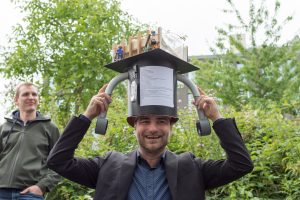
Promotionsprüfung Josefa Oberem, M.Sc.
Am 24. Januar 2020 hat FrauJosefa Oberem, M.Sc, ihre mündliche Promotionsprüfung erfolgreich abgeschlossen.
Frau Oberem promovierte über das Thema:
„Examining auditory selective attention: From dichotic towards realistic environments“
Abstract:
The aim of the present thesis is to examine the cognitive control mechanisms underlying auditory selective attention by considering the influence of variables that increase the complexity of an auditory scene. Therefore, technical aspects such as dynamic binaural hearing, room acoustics and head movements as well as those that influence the efficiency of cognitive processing are taken into account. Step-wise a well-established dichotic-listening paradigm is extended into a “realistic” spatial listening paradigm.
Conducted empirical surveys are based on a dichotic-listening paradigm examining the intentional switching of auditory selective attention. Spoken phrases are simultaneously presented by two speakers to participants from two of eight azimuthal positions. The stimuli are phrases that consist of a single digit (1 to 9, excluding 5), in some experiments followed by either the German direction “UP” or “DOWN”. A visual cue indicates the target’s spatial position, prior to auditory stimulus onset. Afterwards, participants are asked to identify whether the target number is arithmetically smaller or greater than five and to categorize the direction. Reaction time and accuracy are performance measures. Differences of performance measures between the repetition of the target’s spatial position and the related switch (switch costs) describe the loss of efficiency associated with redirecting attention from one target’s location to another. To examine whether the irrelevant auditory information is decoded, interference in the processing of task-relevant and task-irrelevant information is created in the paradigm.
To study the binaural effects in the intentional switching of auditory selective attention, the dichotic-listening paradigm is gradually extended towards a binaural-listening paradigm representing complex dynamic acoustic scenes in the present thesis. In order to realize the extension of the paradigm towards a realistic scene various technical methods and tools need to be applied. As the listening paradigm is step-wise broadened towards realistic scenes the technical methods and tools are assessed with respect to the collected empirical results.
Using the binaural-listening paradigm, the ability to intentionally switch auditory selective attention is tested when applying different methods of spatial reproduction. Essential differences between real sources, an individual and a non-individual binaural synthesis reproduced with headphones as well as a binaural synthesis based on Cross-Talk Cancellation are found. This indicates how the loss of individual information reduces the ability to inhibit irrelevant information. Differences in performance measures occur also with regard to the target’s spatial position. Reliable findings on the spatial localization ability are confirmed applying the listening paradigm on the intentional switching of auditory selective attention. As a step towards multi-talker scenarios in realistic environments participants are tested in differently reverberating environments. Switch costs are highly affected by reverberation and the inhibition is also impaired by to be unattended information. Age-related effects are also found when applying the binaural-listening paradigm, indicating difficulties for elderly to suppress processing the distractor’s speech.
Das ITA gratuliert sehr herzlich!!
